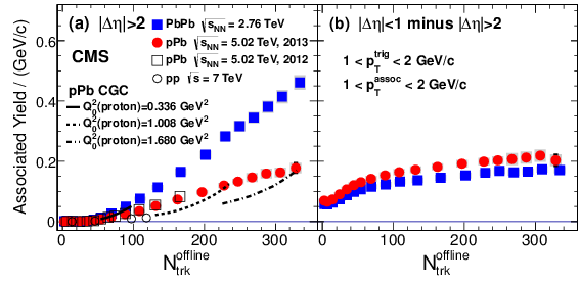

Compact Muon Solenoid
LHC, CERN
| CMS-HIN-13-002 ; CERN-PH-EP-2013-077 | ||
| Multiplicity and transverse momentum dependence of two- and four-particle correlations in pPb and PbPb collisions | ||
| CMS Collaboration | ||
| 4 May 2013 | ||
| Phys. Lett. B 724 (2013) 213 | ||
| Abstract: Measurements of two- and four-particle angular correlations for charged particles emitted in pPb collisions are presented over a wide range in pseudorapidity and full azimuth. The data, corresponding to an integrated luminosity of approximately 31 inverse nanobarns, were collected during the 2013 LHC pPb run at a nucleon-nucleon center-of-mass energy of 5.02 TeV by the CMS experiment. The results are compared to 2.76 TeV semi-peripheral PbPb collision data, collected during the 2011 PbPb run, covering a similar range of particle multiplicities. The observed correlations are characterized by the near-side (abs(Delta(phi)~0) associated pair yields and the azimuthal anisotropy Fourier harmonics (v[n]). The second-order (v[2]) and third-order (v[3]) anisotropy harmonics are extracted using the two-particle azimuthal correlation technique. A four-particle correlation method is also applied to obtain the value of v[2] and further explore the multi-particle nature of the correlations. Both associated pair yields and anisotropy harmonics are studied as a function of particle multiplicity and transverse momentum. The associated pair yields, the four-particle v[2], and the v[3] become apparent at about the same multiplicity. A remarkable similarity in the v[3] signal as a function of multiplicity is observed between the pPb and PbPb systems. Predictions based on the color glass condensate and hydrodynamic models are compared to the experimental results. | ||
| Links: e-print arXiv:1305.0609 [nucl-ex] (PDF) ; CDS record ; inSPIRE record ; Public twiki page ; CADI line (restricted) ; | ||
| Figures | |

png pdf |
Figure 1:
|

png pdf |
Figure 2-a:
|

png pdf |
Figure 2-b:
|

png pdf |
Figure 3:
|

png pdf |
Figure 4:
|

png pdf |
Figure 5:
|

png pdf |
Figure 6:
|

png pdf |
Figure 7:
|

png pdf |
Figure 8:
|

png pdf |
Figure 9:
|

png pdf |
Figure 10:
|

png pdf |
Figure 11:
|

|
Compact Muon Solenoid LHC, CERN |

|

|

|

|

|

|